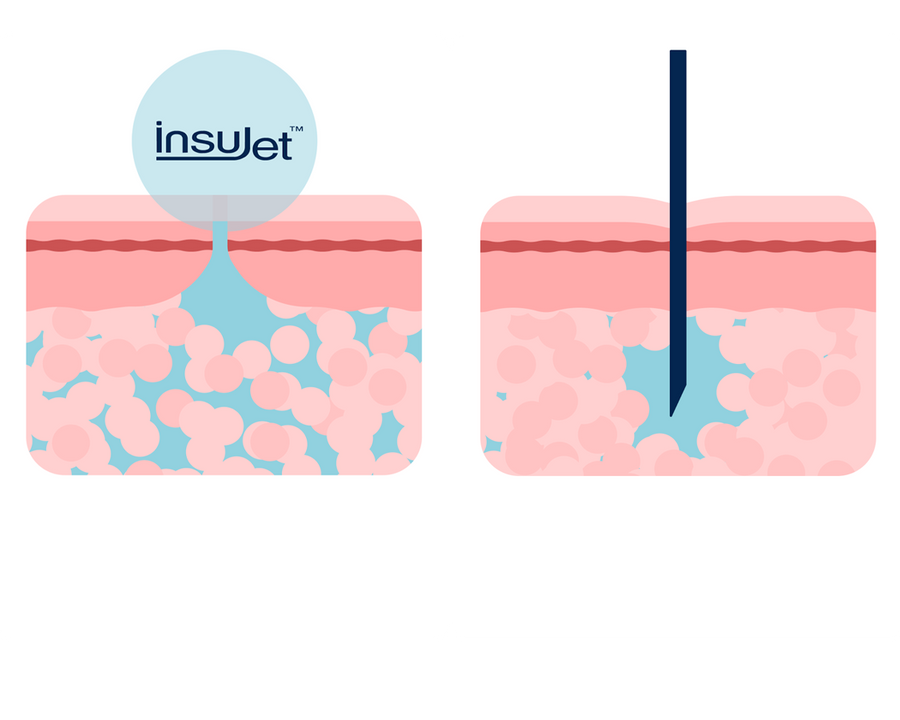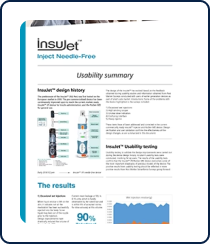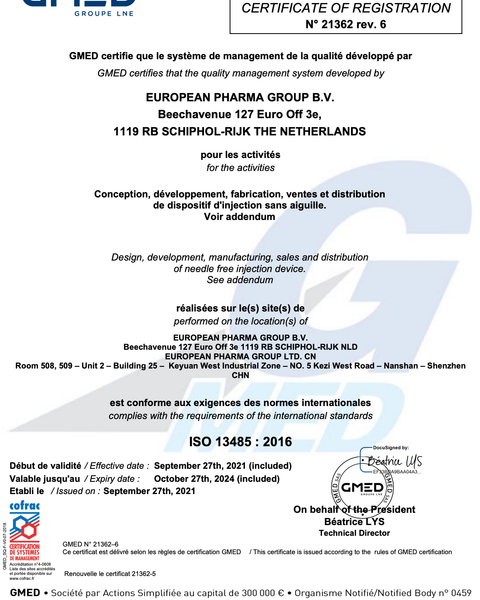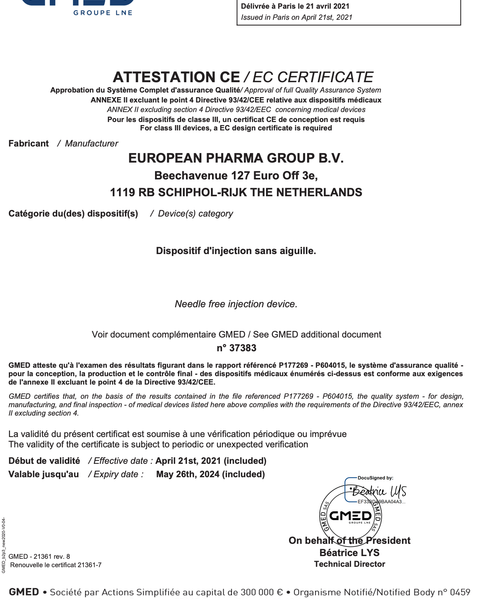The reports are in. Read the Clinical Evidence.
Adult, overweight or obese (BMI ≥25 and ≤40 kg/m2) patients with type 1 diabetes (n=10) or insulin-treated type 2 diabetes (n=10) were enrolled in a randomized, controlled, crossover study. On two separate occasions, patients were instructed to reduce insulin dose(s) to achieve marked hyperglycaemia (18–23 mmol/l). Subsequently, insulin aspart was administered either by jet injection or by conventional pen, in a dose based on estimated individual insulin sensitivity. Pharmacodynamic and pharmacokinetic profiles were derived from plasma glucose and insulin levels, measured for 6 h after injection.
It was concluded that administration of rapid-acting insulin by jet injection results in faster correction of marked hyperglycaemia in overweight or obese patients with insulin-requiring diabetes.
Download documentJet injectors allow needle-free insulin delivery. The study objective was to compare the tolerability and device preference of subcutaneous insulin aspart delivery by jet injector with pen injection in an open-label, randomized, crossover pilot study.
In this small pilot study, the devices were similar in glucose excursion in the area under the glucose concentration–time curve corrected for baseline glucose level and in insulin absorption. Devices were similar for participant preference and relative injection pain.
It was concluded that subcutaneous jet injection of aspart insulin was well tolerated.
Download documentClamp studies have shown that the absorption and action of rapid-acting insulin are faster with injection by a jet injector than with administration by conventional pen. To determine whether these pharmacokinetic changes also exist in patients with diabetes and benefit postprandial glucose control, a comparison was made of the pharmacologic profiles of insulin administration by jet injection versus conventional insulin pen after a standardized meal in patients with type 1 or type 2 diabetes.
Results showed that insulin administration by jet injection resulted in shorter time until peak plasma insulin level and reduced hyperglycemic burden during the first hour compared with conventional administration. Jet injection did not, however, significantly reduce the hyperglycemic burden during the 5-h period thereafter. There was no indication that the jet injector performed differently in patients with type 1 and type 2 diabetes.
It was concluded that the considerably more rapid insulin absorption after administration by jet injector translated to a significant if modest decrease in postprandial hyperglycemia in patients with type 1 and type 2 diabetes. The improved early postprandial glucose control may specifically benefit patients who have difficulty in limiting postprandial glucose excursions.
Download documentIn a euglycaemic glucose clamp study with healthy volunteers it was showed that using jet injectors, rather than conventional pens, significantly improved the time-action profiles of rapid-acting insulin analogs. Here, it was investigated whether such profiles were modified by body mass index (BMI) and related weight parameters by comparing insulin administration by jet injection to that by conventional pen in subgroups defined by BMI, waist-to-hip ratio, waist circumference and insulin dose.
After conventional administration, times to peak insulin levels (T-INSmax) occurred 31.1 [95% confidence interval (CI) 13.7–48.5] minutes later and time to maximum glucose requirement (T-GIRmax) 56.9 (95%CI 26.6–87.3) minutes later in more obese (BMI > 23.6 kg/m2) than in lean subjects (BMI < 23.6 kg/m2). In contrast, T-INSmax and T-GIRmax were similar in subjects with high and low BMI, when insulin was administered by jet injection.
It was concluded that using jet injection for insulin administration may especially benefit subjects with higher body weight.
Download documentInsuJet's clinical trials, performed by a renowned Dutch academic hospital, were performed to com-pare the pharmacologic profile of administration of insulin aspart by jet injection to that by convention-al insulin pen.
Results showed that the time to maximal GIR was significantly shorter when insulin was injected with the jet injector, compared with conventional pen administration. The time to peak insulin concentration was similarly reduced and peak insulin concentrations were increased. Jet injector insulin administration reduced the time to 50% glucose disposal. No differences were measured in maximal GIR, total insulin absorption, or total insulin action between the two devices.
Conclusions were drawn that administration of insulin aspart by jet injection enhances insulin absorption and reduces the duration of glucose-lowering action. This profile resembles more closely the pat-tern of endogenous insulin secretion and may help to achieve better meal insulin coverage and correction of postprandial glucose excursions.
Download documentKey report’s finding
-
0 .
Jet injection of aspart insulin has high tolerability
-
0 .
Better insulin absorption and faster glucose-lowering action
-
0 .
Especially beneficial for people with higher body weight
-
0 .
Improved early postprandial glucose control
One size fits all
The same InsuJet device is suitable for individuals of all sizes, genders, and ages. InsuJet may especially benefit people with a higher Body Mass Index (BMI).
-

<18.5
-

18.5-24.9
-

25-29.9
-

30-34.9
-

35>

Needle-free insulin administration
InsuJet works by pushing liquid under high pressure through a tiny orifice in the front of a nozzle, the liquid gets enough speed and pressure to pass through the skin. Once in the subcutaneous tissue, the liquid follows the path of least resistance, which ensures good distribution of the liquid.
-
ISO 13485
-
CE CERTIFIED
-
TGA
-
HEALTH CANADA
-
NHS COVERED
Additional Information
We ship all around the world... Please provide here you own shipping information, including times, prices, options etc.
This depends on whether it is an International or a Domestic order. All orders within the U.S. are considered domestic orders and they are shipped and delivered within 2-5 business days. Please see International Orders for more details.
We accept PayPal, Visa, MasterCard, Discover, and American Express but feel free to contact us for other payment options.

We will send tracking information to the e-mail address associated with your order once the item has shipped. If you have not received your tracking information and it has been over 2 business day, please contact us at (012) 123 - 4567
When ordering as a gift for someone, be sure to enter in your email address to receive all summary information but enter in the recipient’s name and shipping information. We will be sure to keep all prices and receipts out of the package.
If for any reason you are not completely satisfied with your purchase, within 30 days of placing your order, we will refund you for your purchase with no questions asked.






